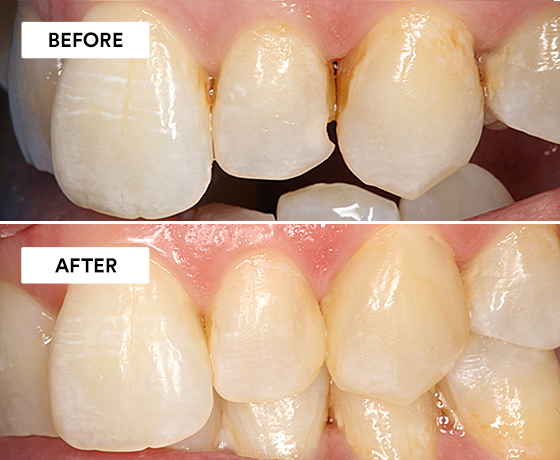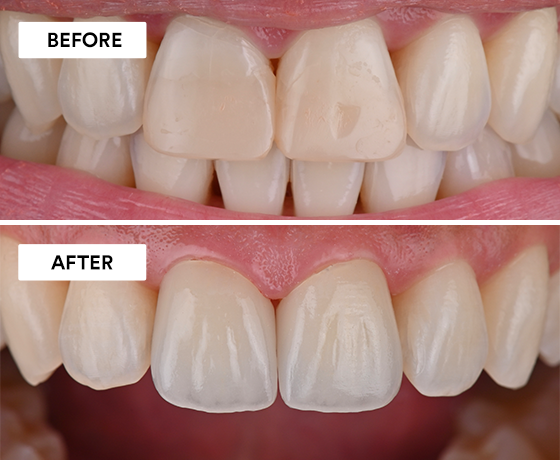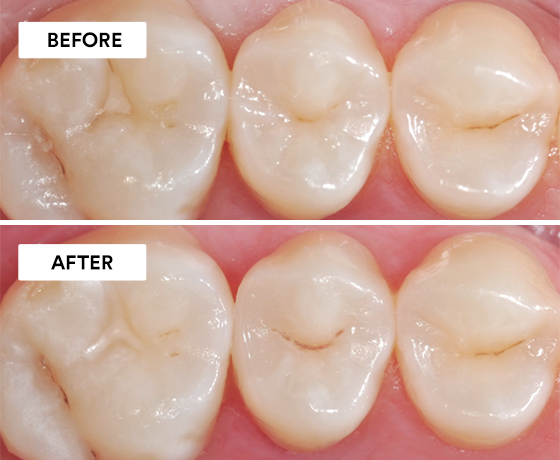Clinical Case: Is it possible to do more with less? Cracking the chameleon effect
Using 3M™ Filtek™ Easy Match Universal Restorative.


A 40-year-old patient from Belgium presented in our dental office in Lithuania for a regular check-up. She was in the country for a few days only, so that the spontaneous decision to restore her worn mandibular incisors caused some time pressure.
After having analyzed the clinical situation, it was obvious that restoring the teeth with resin composite would be challenging. The reason was that the teeth had a complex color structure with a dark basic shade and some greyish areas, which would be difficult to reproduce quickly. We also detected wear offs, micro cracks and exposed, stained dentin primarily on the central incisors to be masked, and irregular incisal edges as well as open contact points to be restored with the right shade and opacity.
Despite these challenges and due to time restrictions, we opted for a quick and simple solution: the single-shade technique with 3M™ Filtek™ Universal Restorative. The material was chosen mainly due to its universal, body-like opacity, which was trusted to be transparent enough to blend in nicely with the natural dentition and opaque enough to conceal the micro-cracks and infiltrated areas.

Figure 1: Initial situation with enamel wear and exposed dentin in the anterior area of the mandible. Several micro cracks are visible as well.

Figure 2: The lateral view of the lower anterior teeth …

Figure 3: … reveals open interdental spaces as well.

Figure 4: Clinical situation after surface micro-scratching and creation of micro grooves for better light dispersion using a coarse diamond at a speed of 10,000 rpm. This will help to conceal the restoration margins at the incisal edge.

Figure 5: Sandblasting with the 3M™ CoJet™ System to remove the rest of unsupported free enamel prisms and hyper-mineralized fluorapatite.

Figure 6: Roughened and cleaned tooth surfaces ready for the bonding and restoration procedures.

Figure 7: The lateral view reveals the created micro grooves and surface roughness in the incisal area of the anterior teeth.

Figure 8: Etching with phosphoric acid (3M™ Scotchbond™ Universal Etchant) for 15 seconds. The adjacent teeth are protected with transparent matrix strips.

Figure 9: Frosty. Etched enamel surfaces perfect for application of the universal adhesive.

Figure 10: Application of 3M™ Scotchbond™ Universal Adhesive with a brush for better access to the interdental spaces. The adhesive is rubbed in for 20 seconds, gently treated with air until the adhesive surface stops moving and light cured for 10 seconds.

Figure 11: Protection of the adjacent teeth using PTFE tape before starting to restore the lateral incisors.

Figure 12: Application of 3M™ Filtek™ Universal Restorative in the shade D3, which perfectly matches the shade of the teeth. The idea was to let the dark-greyish tooth color shine through the composite material for even better integration.

Figure 13: Application of 3M™ Filtek™ Universal Restorative in the shade D3 to the left lateral incisor. Even with the reduced number of shades available, an exact reproduction of the patient’s tooth color is possible in the majority of cases.

Figure 14: Result of the lateral incisor restoration procedure after light curing. The incisal edges are invisible under the layer of composite. Its transparency is just right for a natural appearance on the teeth and in composite-only areas.

Figure 15: Clinical situation after build-up of the central incisors with the same material. Indeed, the selected material with its universal opacity is able to conceal the micro cracks and stained dentin without compromising esthetics.

Figure 16: Pre-polishing of the four composite restorations with the beige spiral wheel of the 3M™ Sof-Lex™ Diamond Polishing System.

Figure 17: High-gloss polishing with the pink wheel of the 3M™ Sof-Lex™ Diamond Polishing System. Thanks to nanofiller technology, 3M™ Filtek™ Universal Restorative offers great polishing properties.

Figure 18: Lateral view of the treatment result revealing the tooth-like gloss of the restoration surfaces. Polish retention is also great and similar to that of the proven 3M™ Filtek™ Supreme XTE Universal Restorative.

Figure 19: Frontal view of the treatment result. The case demonstrates nicely that the selected composite is very well suited to solve many restorative problems in a quick and simple way.

Figure 20: Image of the final situation taken with a polarizing filter. The filter removes reflections from the surface and allows us to analyze the color structure, confirming a great optical integration of the universal restorative.

Using 3M™ Filtek™ Easy Match Universal Restorative.

Using 3M™ Imprint™ 4 Light VPS Material, 3M™ Intra-oral Syringe, 3M™ Imprint™ 4 Heavy VPS Material, 3M™ Protemp™ 4 Temporization…

Using 3M™ Scotchbond™ Universal Etchant, 3M™ Scotchbond™ Universal Adhesive, 3M™ Elipar™ DeepCure-S LED Curing Light, 3M™ Filtek™ One Bulk Fill…